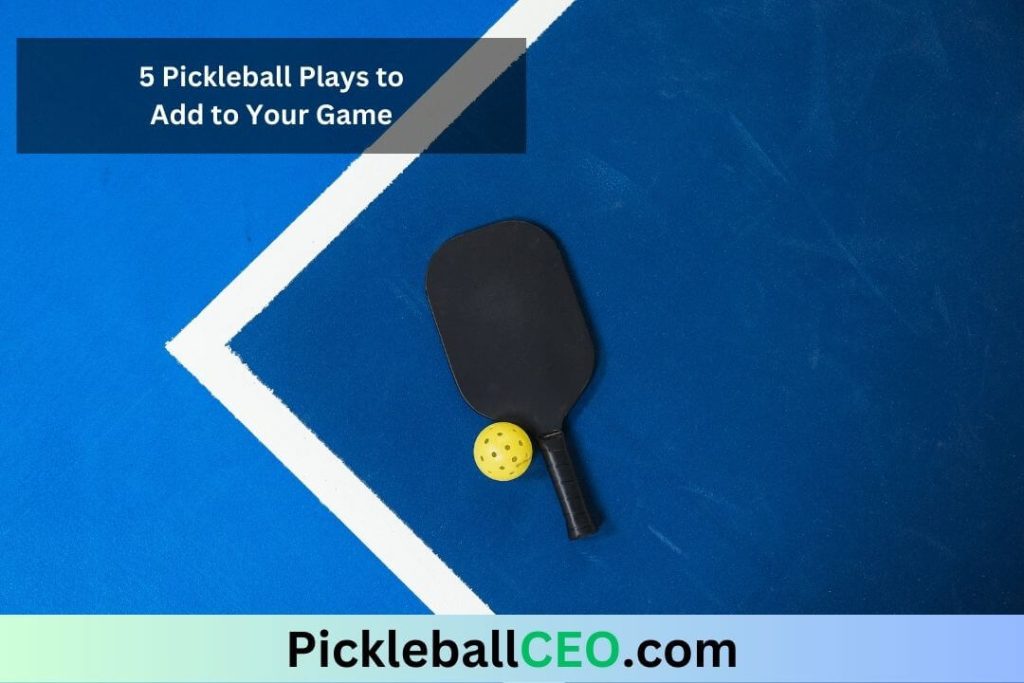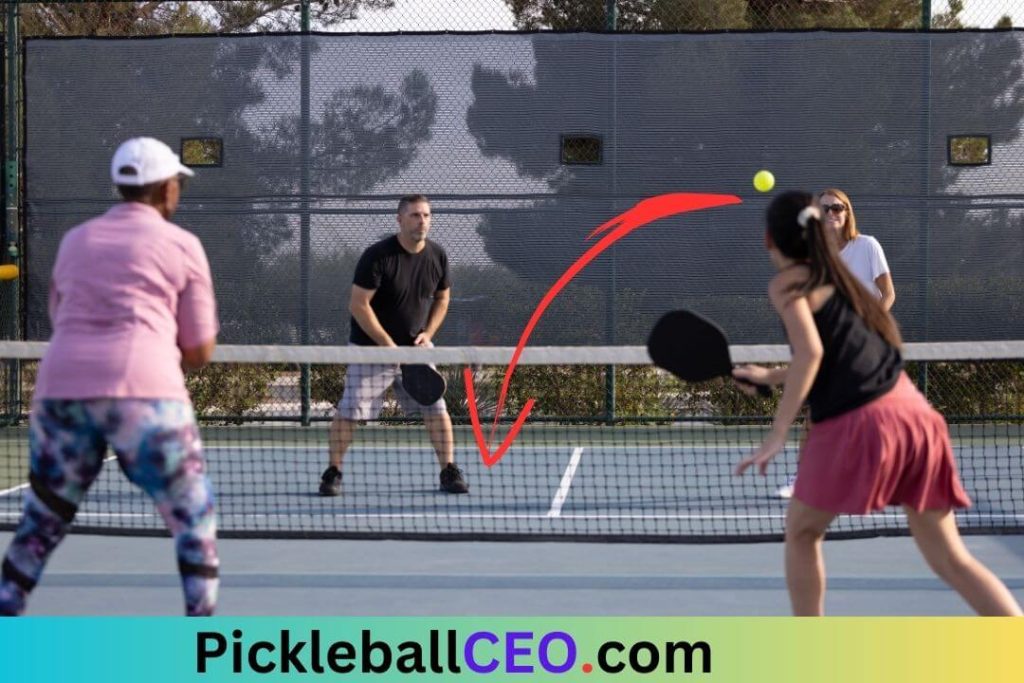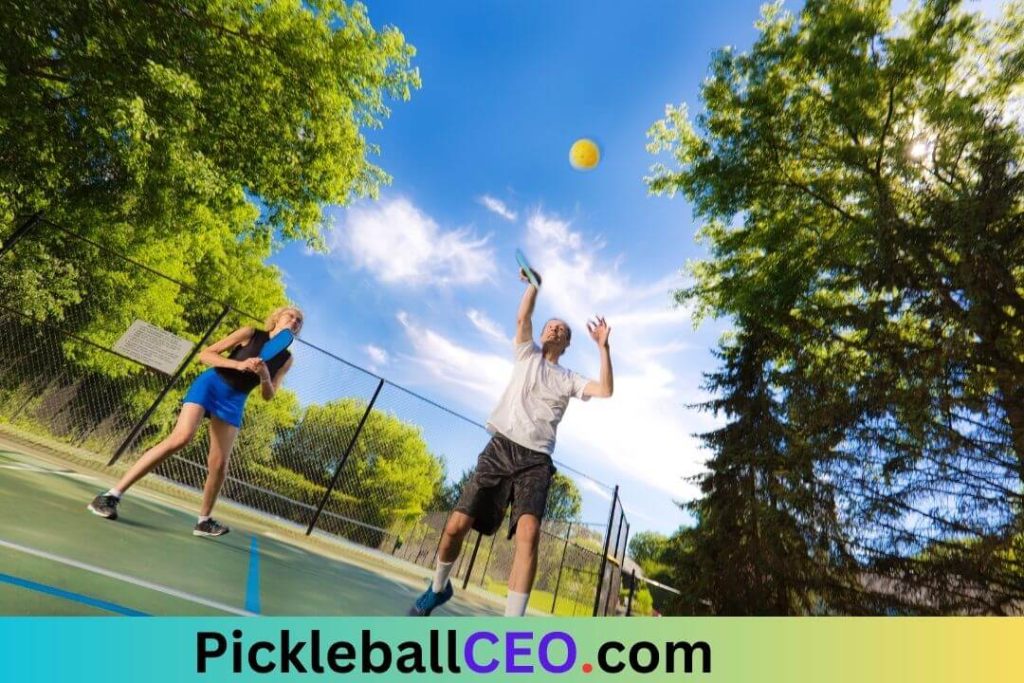Introduction About Your Game
Pickleball, the fast-paced and exciting sport that combines elements of tennis, badminton, and ping pong, has been capturing the hearts of players of all ages and skill levels. As you progress in your pickleball journey, adding new plays to your repertoire can elevate your game and make you a more formidable opponent on the court. In this article, we will explore five essential pickleball plays that you can incorporate into your strategy to enhance your performance and outsmart your opponents.


1. The Third-Shot Drop


Strategic Net Advancement
The third-shot drop is not only a crucial play to initiate a pickleball rally, but it also serves as a strategic method to advance to the net. By hitting a soft and controlled shot into the opponent’s NVZ, you and your partner can move forward to take a dominant position at the net. Being at the net puts you in a better position to control the point and intercept your opponents’ shots.
Forcing Upward Shots
The beauty of the third-shot drop lies in its ability to force your opponents to hit upward shots. When the ball lands softly in the NVZ, your opponents are restricted from making powerful offensive shots. Instead, they have to hit the ball from a lower position, limiting their options and potentially setting up a weak return that you can capitalize on.
Setting the Pace of the Game
Mastering the third-shot drop allows you to dictate the pace of the game. By controlling the tempo through well-placed drops, you can slow down the game and disrupt your opponents’ rhythm. This deliberate change in pace can frustrate opponents who prefer a faster game, giving you a psychological advantage on the court.
2. The Erne Shot
A Risky Yet Rewarding Move
The Erne shot is a high-risk, high-reward play that requires excellent timing and athleticism. Jumping outside the court’s boundary lines to hit the ball requires split-second decision-making and precision. When executed successfully, the Erne shot catches opponents by surprise, leaving them with little time to react to the unorthodox angle of the shot.
Creating Angles and Openings
The Erne shot is particularly effective at creating unique angles and openings on the court. By hitting the ball from outside the court, you can direct it into areas that your opponents might not expect. This unexpected placement can force your opponents to scramble and open up opportunities for you and your partner to take control of the rally.
Psychological Impact
Apart from its tactical advantages, the Erne shot can have a strong psychological impact on opponents. The daring and unconventional nature of the play can create uncertainty and doubt in their minds. This mental pressure can lead to unforced errors or hesitant shots from your opponents, giving you an edge in the match.
Stay tuned for the continuation of this article, where we will explore three more essential pickleball plays to add to your game, helping you become a more well-rounded and strategic player on the pickleball court.
3. The Fake-Out Dink


Misleading Your Opponents
The fake-out dink is all about deception and outsmarting your opponents. By initially mimicking the motion of a standard soft dink shot, you lull your opponents into expecting a gentle shot close to the net. However, at the last moment, you surprise them with a deeper and faster shot that pushes them back towards the baseline. This unexpected change in shot selection catches opponents off balance and disrupts their positioning, giving you an advantage in the rally.
Creating Space for Aggressive Plays
The main objective of the fake-out dink is to create space for more aggressive shots. By pushing your opponents away from the net, you open up the court and expose gaps in their defense. This provides you with opportunities to execute powerful groundstrokes or even approach the net for a put-away volley. The fake-out dink is an effective way to set up offensive plays and gain control of the point.
Timing and Execution
Mastering the fake-out dink requires impeccable timing and execution. The key is to make the shot look identical to your regular soft dink until the last possible moment. It’s crucial to maintain the same grip, paddle angle, and body positioning during the shot’s setup phase. The element of surprise is what makes this play effective, so keep your opponents guessing and capitalize on their momentary confusion.
4. The Poach
Working as a Dynamic Team
The poach is a strategic play that highlights the importance of teamwork and communication between partners. As the non-hitting partner, your role is to read the game, anticipate your opponents’ shots, and seize opportunities to intercept the ball. Communication with your partner is vital to ensure that you both know when and how the poach will be executed.
Catching Opponents Off Guard
The element of surprise is a significant advantage of the poach. When executed at the right moment, your poaching move can catch your opponents off guard, leaving them with little time to react or adjust their shot. This puts you in a favorable position to take control of the rally and potentially put the opponents on the defensive.
Timing and Anticipation
To execute the poach successfully, keen anticipation and quick footwork are essential. Pay close attention to your opponents’ shot selection, and be prepared to move swiftly to intercept the ball. As you anticipate their shot, position yourself strategically, and be ready to cover the net effectively. The poach is a skill that improves with experience, so practice reading the game and refining your timing to make it a potent weapon in your pickleball arsenal.
5. The Lob
Countering Aggressive Net Play
The lob is a defensive play used to neutralize aggressive opponents who are crowding the net. When your opponents are applying pressure with their net play, the lob offers a tactical solution. By sending the ball high over their heads and deep into the backcourt, you force them to retreat and give you and your partner more time to reposition yourselves.
Resetting the Rally
The lob can be a valuable tool to reset the rally to a more neutral state. When you and your partner are out of position or under pressure, executing a well-timed lob gives you both the chance to recover and regain control of the point. The lob shot also disrupts your opponents’ offensive momentum, creating an opportunity for you to turn the tide in your favor.
Practice and Precision
To be effective with lobs, practice is essential. Achieving the right height and distance requires precision and skill. Work on your timing and ball-tossing technique to consistently execute accurate lobs. Aim to place the lob deep into your opponents’ backcourt, making it challenging for them to attack it effectively.
Incorporating these five essential pickleball plays into your game can enhance your skillset and make you a more well-rounded player on the court. Remember, practice, patience, and a willingness to try new strategies are keys to success in mastering these plays. As you add these plays to your pickleball arsenal, you’ll be better equipped to outmaneuver your opponents and elevate your game to new heights.
Conclusion
Adding these five pickleball plays to your game can significantly enhance your performance and strategic abilities on the court. The third-shot drop allows you to advance to the net and control the pace of the game, while the Erne shot surprises opponents with its daring execution. The fake-out dink adds an element of deception to outmaneuver your opponents, and the poach relies on teamwork and anticipation to seize control of the rally.
Finally, the lob provides an effective defensive tool to counter aggressive net play and reset the tempo of the game. By mastering these plays through practice and dedication, you’ll become a more versatile and formidable pickleball player, ready to take on any challenge and excel in this thrilling sport. So, step onto the court with confidence, apply these plays to your game, and enjoy the exhilarating journey of becoming a top-notch pickleball player.







Comments (5)
The Ultimate Guide to Pickleball Nets: Ensuring Fair Play - Pickleball CEOsays:
July 22, 2023 at 11:10 am[…] in accordance with the specific rules and regulations of the organization or event in which the game is being played. Always ensure that any modifications comply with the appropriate guidelines to maintain fair and […]
5 Easy Tips To Start Playing Pickleball - Pickleball CEOsays:
July 22, 2023 at 11:18 am[…] points can be scored by the serving or receiving team. A point is awarded for every rally won, and games are typically played to 11 or 15 points. However, specific rules may vary depending on the level of play or tournament […]
Kids First Fundraiser Pickleball Tournament: A Fun-filled Event - Pickleball CEOsays:
July 23, 2023 at 4:04 am[…] Mark your calendars for July 21 to July 23 and come to the Saco Sports Arena in Saco, ME, ready to play your best pickleball game and make lasting […]
5 Of The Coolest Pickleball Courts In The US - Pickleball CEOsays:
August 8, 2023 at 11:50 am[…] for seamless play even after sunset. The well-designed lighting ensures visibility and enhances the playing experience during evening games. Whether you prefer playing during the day or under the stars, Indian Wells Tennis Garden […]
5 of the Best Pickleball Shots Every Player Needs to Know - Pickleball CEOsays:
August 8, 2023 at 12:10 pm[…] To execute an effective third shot drop, focus on accuracy, control, and placement. You want to aim for the NVZ, close to the opponent’s baseline, to limit their options and force them into a defensive position. Practice your touch and finesse to ensure the ball clears the net and lands softly in the desired location. Developing consistency with your third shot drop will enhance your ability to control the tempo of the game and create opportunities for offensive plays. […]